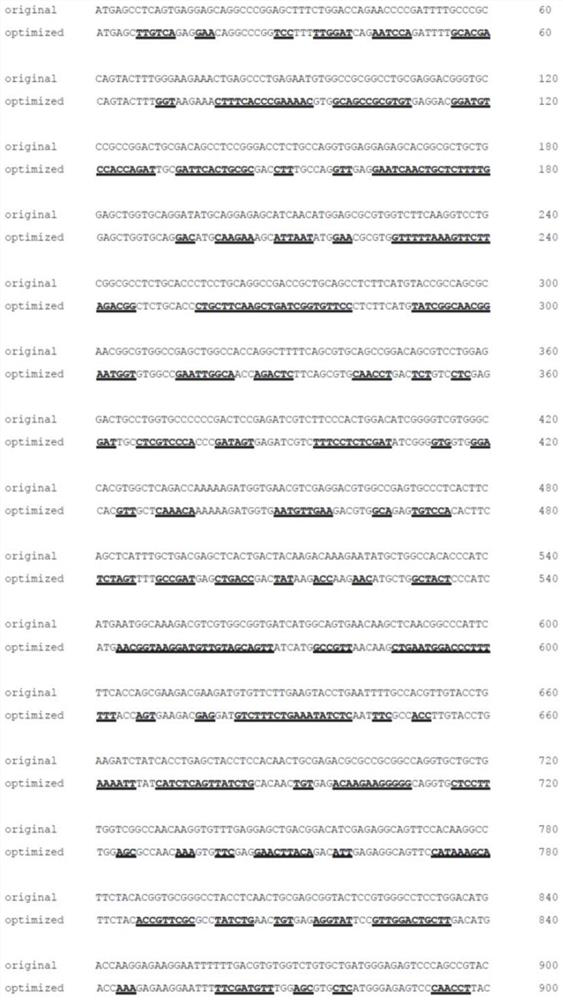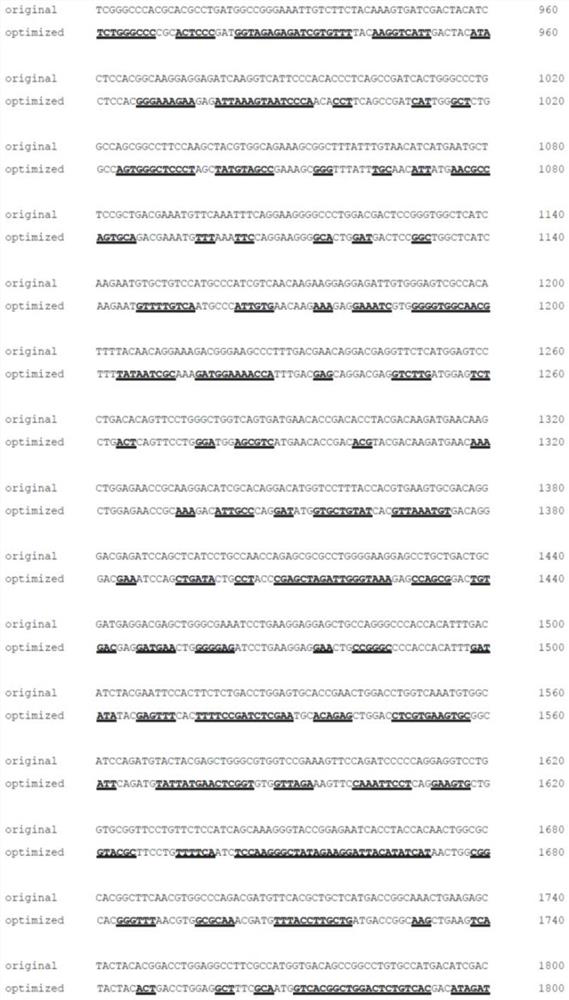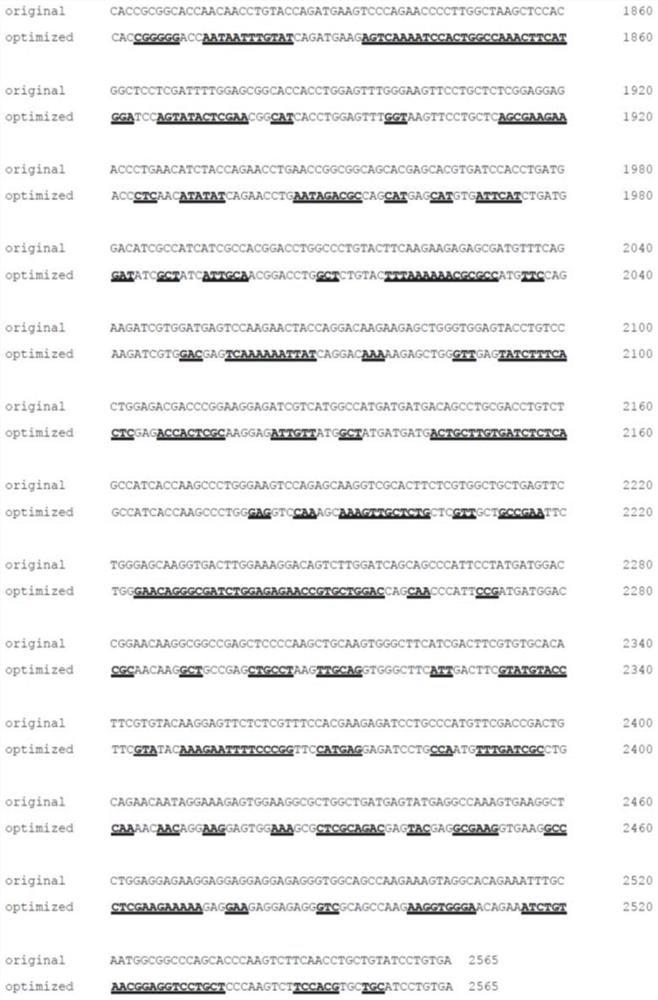PDE6B nucleotide sequence and use thereof
A nucleotide sequence and sequence technology, applied in the PDE6B nucleotide sequence and its application field, can solve the problems of transducing retinal tissue cells, etc., and achieve the effects of preventing or treating retinitis pigmentosa, increasing thickness, and strong stimulation response
- Summary
- Abstract
- Description
- Claims
- Application Information
AI Technical Summary
Problems solved by technology
Method used
Image
Examples
Embodiment 1
[0043] Example 1: Codon-optimized PDE6B vector construction and expression verification
[0044] (1) Plasmid vector construction
[0045] 1. Digest the backbone of the AAV2-CAG plasmid and the coPDE6B fragment or wtPDE6B fragment simultaneously with HindIII and XhoI respectively, and then ligate the digested fragments to the backbone respectively.
[0046] 2. The ligation product was transformed into E. coli, and a single colony was picked for enzyme digestion verification and sequencing verification.
[0047] (2) Cell transfection
[0048] 1.293 cells were plated in the cell culture well plate, and the cells were grown until the confluence reached 70-80%.
[0049] 2. Replace the medium with DMEM+1XGlutaMAX.
[0050] 3. Dilute the plasmid and PEI reagent with culture medium and mix well at a ratio of 1:2. After mixing, let stand at room temperature for 20 minutes, add the mixture to the cell culture medium, and shake gently.
[0051] 4. Place the cell culture plate in 37°C...
Embodiment 2
[0070] Example 2: CAG promoter has higher expression efficiency in rd10 mice
[0071] (1) Mice injected with virus drugs
[0072] 1. Prepare 5*10 12 vg / ml of AAV2 / 2.7m8-CAG-coPDE6B, AAV2 / 2.7m8-sCBA+AT2RIntron 1-coPDE6B and AAV2 / 2.7m8-sCBA-coPDE6B drugs.
[0073] 2. Inject 1 ul / eye of the above three viruses into the eyes of different age-appropriate rd10 mice respectively through the vitreous cavity or subretinal injection.
[0074] 3. At 3 weeks after the mice were injected, the mice were sacrificed, and the retinal tissues of the mice were separated.
[0075] (2) qPCR detection of PDE6B mRNA expression level
[0076] 1. Pre-cool the mortar with liquid nitrogen, add mouse eye tissue into the mortar and grind it into powder.
[0077] 2. Transfer the powder into an EP tube filled with Trizol lysate, shake vigorously and let stand at room temperature for 5 minutes, then centrifuge at 10,000 rpm and 4°C for 10 minutes.
[0078] 3. Transfer the supernatant to a new EP tube, a...
Embodiment 3
[0087] Example 3: AAV-coPDE6B gene therapy drug improves ocular function and repairs retinal structure in rd10 mice
[0088] (1) Mice injected with virus drugs
[0089] 1. Prepare 5*10 12 vg / ml of AAV2 / 2.7m8-CAG-coPDE6B drug and AAV2 / 2.7m8-CAG-GFP.
[0090] 2. Inject 1 ul / eye of AAV2 / 2.7m8-CAG-coPDE6B drug and AAV2 / 2.7m8-CAG-GFP virus into the eyes of age-appropriate mice through the vitreous cavity or subretinal injection.
[0091] 3. At 3 weeks after the mice were injected, the mice were sacrificed, and the retinal tissues of the mice were separated and made into slices for later use.
[0092] (2) Electroretinogram analysis
[0093] 1. The mice were anesthetized and the pupils were dilated, and at the same time, 2.5% hypromellose liquid containing electrodes was dripped into the eyes, and the corneal potential response was recorded.
[0094] 2. Under the condition of dark adaptation, let the mice adapt to the dark overnight, give short-term flash stimulation with differe...
PUM
 Login to View More
Login to View More Abstract
Description
Claims
Application Information
 Login to View More
Login to View More - R&D
- Intellectual Property
- Life Sciences
- Materials
- Tech Scout
- Unparalleled Data Quality
- Higher Quality Content
- 60% Fewer Hallucinations
Browse by: Latest US Patents, China's latest patents, Technical Efficacy Thesaurus, Application Domain, Technology Topic, Popular Technical Reports.
© 2025 PatSnap. All rights reserved.Legal|Privacy policy|Modern Slavery Act Transparency Statement|Sitemap|About US| Contact US: help@patsnap.com



